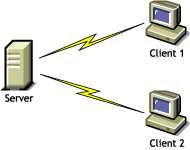4.2 Auto Configuration
Auto configuration is best suited for setups where the time provider is expected to change frequently because, it does not require the time consumer to be reconfigured when the time provider changes.
Thus, the setup can be reconfigured in a single step without modifying the configuration of the time consumers in the network.
You can configure a time-synchronized setup using auto configuration by completing the following tasks:
4.2.1 Planning the Setup
You must plan the setup to identify a time provider. Identify the most reliable server in the subnet and make it the broadcast or multicast server.
4.2.2 Configuring the Time Provider
Broadcast
Add the following line in the time provider's ntp.conf file (located in sys:\etc to broadcast the time synchronization service on the network:
broadcast subnet_broadcast_address key key_ID
Multicast
Add the following line in the time provider's ntp.conf file (located in sys:\etc to multicast the time synchronization service on the network:
broadcast 224.0.1.1 key key_ID
4.2.3 Configuring the Time Consumers
Broadcast
To make the time consumer listen to the broadcast of the time provider's time synchronization service, add the following line to its ntp.conf file.
broadcastclient subnet_broadcast_address
NOTE:The subnet broadcast address variable is optional.
Multicast
To make the time consumer listen to the multicast of the time provider's time synchronization service, add the following line to its ntp.conf file.
multicastclient
4.2.4 Sample Scenario
This sample scenario in the following figure demonstrates how to configure a setup using auto configuration.
Figure 4-4 Sample Scenario for Auto Configuration

In this scenario:
-
Server1 broadcasts its time synchronization service to all the time consumers in the subnet
-
Client1 and Client2 are two time consumers in the subnet that listen to the broadcast
To use auto configuration to configure the setup in this scenario:
-
Add the following line to the ntp.conf file of Server1:
broadcast subnet_broadcast_address key key_ID
-
Add the following line to the ntp.conf file of Client1 and Client2:
broadcastclient subnet_broadcast_address -
Load XNTPD for the changes to take effect.
To do this, enter the following at the command prompt:
Load XNTPD